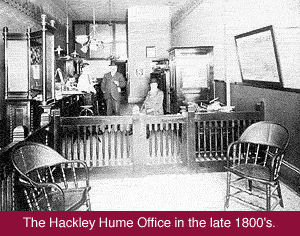|
Charles always felt that education was of most importance, a belief he supported in his gift of $30,000 in 1892 to build a manual training school. Here young people could learn how to make a living with their hands rather than in business or in clerical employment. Our vocational educational programs of today have roots in this type of school.
 By 1897, the school was completed; Charles gave $5,000 each year toward instructors pay and endowed the school with a $100,000 trust fund, the income from which was to be used in paying future salaries. By 1897, the school was completed; Charles gave $5,000 each year toward instructors pay and endowed the school with a $100,000 trust fund, the income from which was to be used in paying future salaries.
By 1900, the enrollment had outgrown the school so that a separate building had to be built as well as two additions to the original structure. In total, Charles spent over $200,000 in building and equipping the school and its endowment fund.
Schools were not Charles Hackleys only interest. He gave freely of his wealth to the betterment of the city where he made his millions. Much of his belief was founded upon Andrew Carnegies Gospel of Wealth, written in 1889. Like other entrepreneurs of the time, Charles felt that his wealth should be used not only to correct hardship and misfortune but also to benefit those who wished to better themselves.
In an interview, Charles Hackley said that:
a rich man to a great extent owes his fortune to the public. He makes money largely through the labor of his employees.....Moreover, I believe that it should be expended during the lifetime of the donor, so that he can see that his benefactions do not miscarry and are according to his intent....To a certain extent, I agree with Mr. Carnegie ....that it is a crime to die rich.
The list of the Hackley donations is a long one, but truly remarkable. Some of these would include:
" Hackley Public Library - Site, Building and Contents
" Hackley Public Library Endowment
" Hackley Art Gallery - Site, Building and Contents
" Hackley Art Gallery Picture Fund
" Hackley Park
" Hackley Manual Training School and Gymnasium - Site, Building and Contents
" Hackley Athletic Field
" Hackley Hospital - Site, Buildings and Contents
" Hackley Hospital Endowment
" Soldiers Monument in Hackley Park
" Statues in Hackley Park
" City of Muskegon Poor Fund Endowment
" Julia E. Hackley Educational Fund Endowment
" Muskegon Humane Union Endowment
The total of all of these gifts had a value of about $6,000,000, an enormous sum even today.
In 1887, Charles purchased lots in the city of Muskegon, one of which he sold to his friend and business partner Thomas Hume. The men hired an architect from Grand Rapids named David Hopkins who designed and built their magnificent homes and carriage barn. The houses were completed in 1889 and the men moved in with their families. Thomas and his wife Margaret had a family of seven, whereas Charles and his wife Julia had only two children and the differences are very evident in the houses. The Hackley Mansion was a built as a show place while the Hume house is a family home.
Late in the 1890s, Charles experienced health problems and traveled to Salt Lake City for treatments, which seemed to help. Despite his illness, he reported for work every day, even two days prior to his death. On February 10, 1905. Charles Hackley died of an aneurysm.
His many accomplishments are well remembered in the town where he gained his fortune, mostly through his many gifts and his handsome home, now on the State and National Historic Registers.
|



 By 1897, the school was completed; Charles gave $5,000 each year toward instructors pay and endowed the school with a $100,000 trust fund, the income from which was to be used in paying future salaries.
By 1897, the school was completed; Charles gave $5,000 each year toward instructors pay and endowed the school with a $100,000 trust fund, the income from which was to be used in paying future salaries.